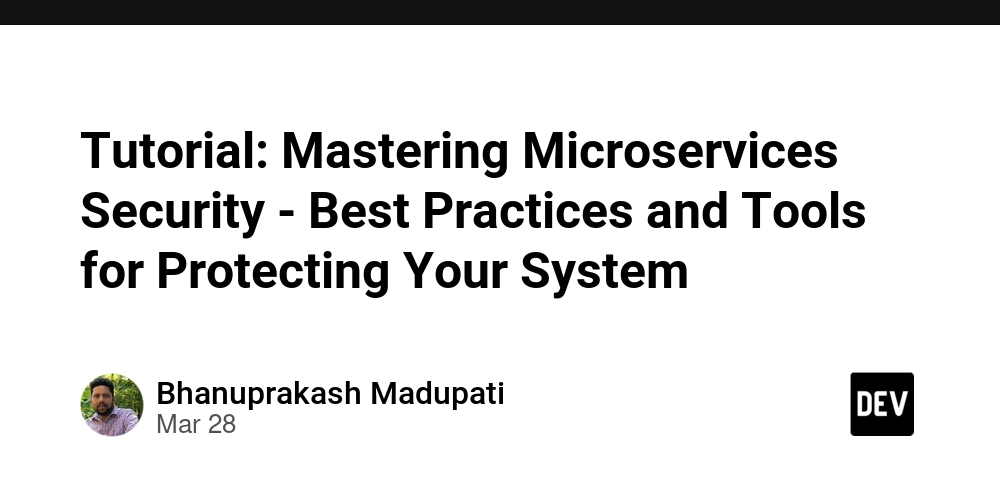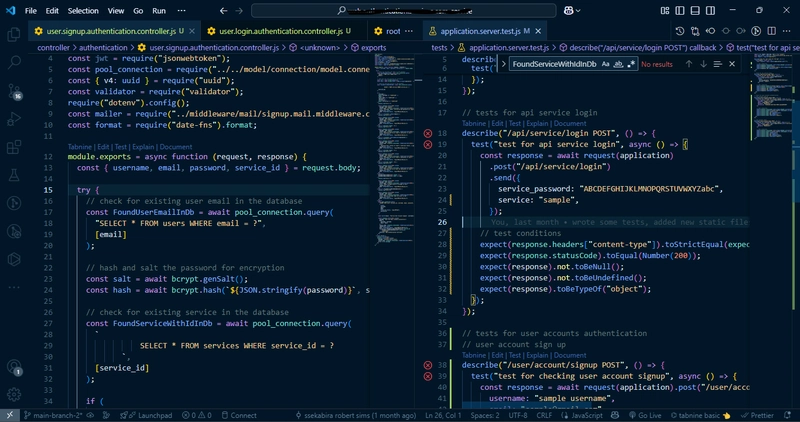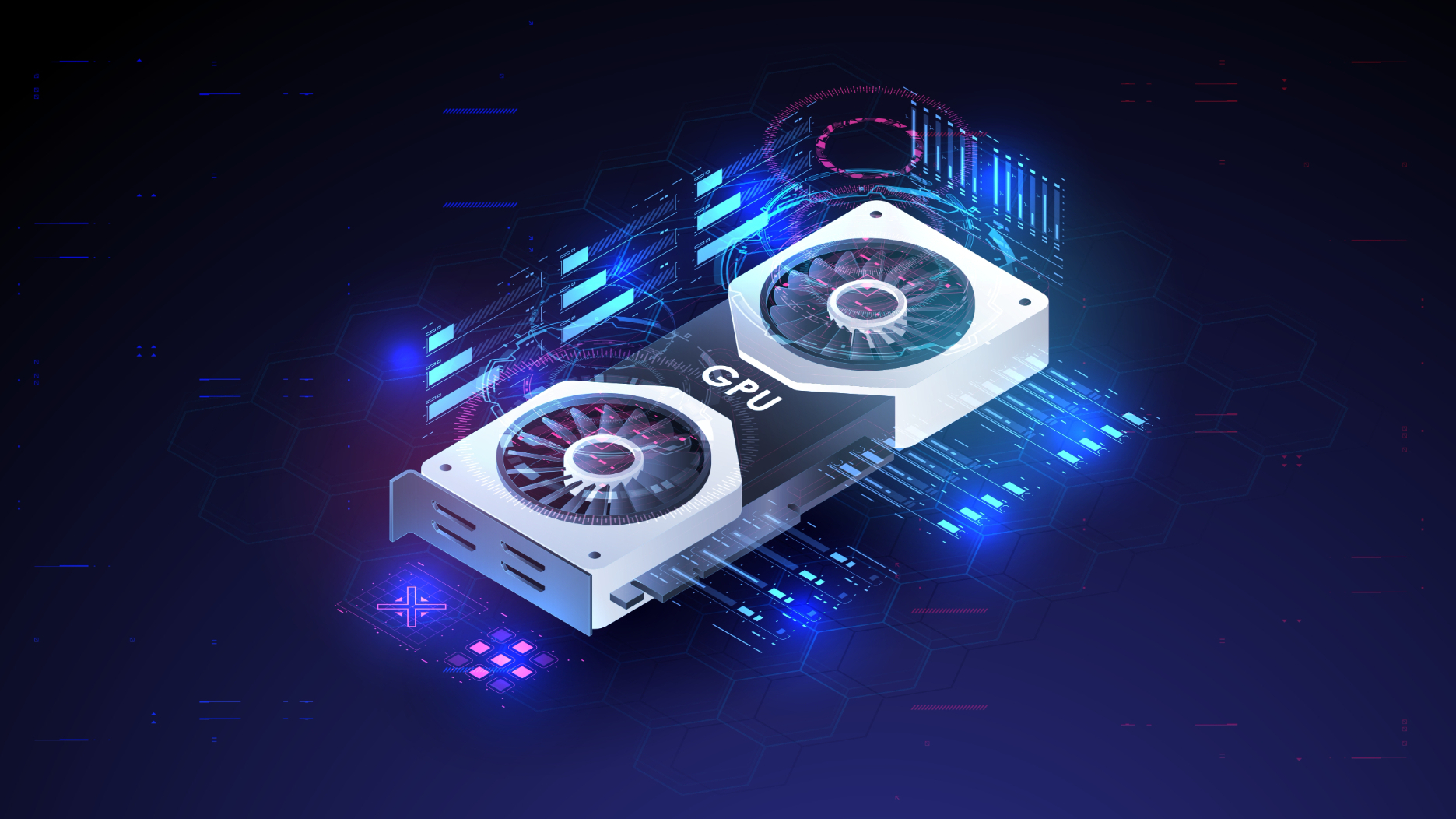Tutorial: Mastering Microservices Security - Best Practices and Tools for Protecting Your System
Microservices architecture has become a popular approach for developing scalable and maintainable applications. However, as systems grow more distributed, securing microservices becomes increasingly complex. In this tutorial, we will explore key concepts, best practices, and tools to secure your microservices effectively. 1. Introduction to Microservices Security Microservices security addresses the various risks associated with distributed systems. Unlike monolithic applications, microservices run as independent services that interact with each other via APIs or messaging. This creates unique challenges in terms of managing access, communication, and data protection. In a microservices architecture, the primary security goals are: Confidentiality: Ensuring data is accessible only to authorized entities. Integrity: Ensuring data is not altered in unauthorized ways. Availability: Ensuring services remain accessible and resilient under attack. 2. Common Threats and Vulnerabilities in Microservices Before diving into security best practices, let's identify some common threats in microservices: Unauthorized Access: With many services interacting with each other, there are numerous potential points of entry for attackers. Data Breaches: Sensitive data might be exposed if services don't properly validate or encrypt the data they handle. Misconfigured Services: Incorrectly configured services can leave vulnerabilities exposed, such as open ports or unsecured endpoints. Service-to-Service Communication Attacks: Attackers might exploit insecure communications between microservices. Denial of Service (DoS): Attackers may try to flood a service with requests, causing it to crash or become unresponsive. 3. Security Best Practices for Microservices To protect your microservices, consider implementing the following security best practices: a. Secure Communication (TLS/SSL) In a distributed system, it’s crucial to ensure that communication between services is encrypted. Use Transport Layer Security (TLS) or Secure Sockets Layer (SSL) to encrypt data in transit. This prevents attackers from intercepting sensitive information during transmission. How to implement: Use TLS certificates to encrypt the communication channels between services. Most cloud platforms like AWS and Azure offer easy TLS setup for internal communication. b. Authentication and Authorization (OAuth, JWT) Properly authenticating and authorizing users and services is a must. OAuth 2.0 and JSON Web Tokens (JWT) are commonly used standards for handling authentication and authorization in microservices. How to implement: Use OAuth 2.0 for secure delegated access. When a user logs in, they receive a token that can be used to access multiple microservices. Use JWT for transmitting user claims and verifying tokens between services. Keycloak and Auth0 are popular identity management solutions for integrating OAuth 2.0 and JWT into your microservices. c. API Security (Rate Limiting, Input Validation) Since microservices communicate via APIs, securing these APIs is critical. Implement measures such as: Rate Limiting: Prevent API abuse by limiting the number of requests a client can make to a service in a given time frame. Input Validation: Ensure that data inputted by users or services is sanitized to avoid SQL injection or cross-site scripting (XSS) vulnerabilities. How to implement: Use API Gateways (e.g., Kong, NGINX) to manage API traffic and implement rate limiting, as well as input validation libraries in your API code (e.g., express-validator for Node.js). d. Service-to-Service Authentication For secure communication between microservices, you need to authenticate the services themselves. Instead of relying on traditional user authentication methods, implement mutual TLS (mTLS) or a service mesh. How to implement: mTLS: This involves certificates that verify both the client and server during communication. Service Mesh: A tool like Istio can manage service-to-service authentication and encryption, reducing the complexity of dealing with individual certificates. e. Centralized Logging and Monitoring Monitoring is crucial to detect malicious activity and performance issues in real-time. Implement centralized logging and monitoring systems that aggregate logs from all services, making it easier to detect anomalies. How to implement: Use Prometheus and Grafana for monitoring. Implement logging tools like ELK Stack (Elasticsearch, Logstash, Kibana) or Splunk to centralize logs. Jaeger or Zipkin can help with distributed tracing to monitor interactions between microservices. 4. Tools to Enhance Microservices Security Several tools can help you enhance the security of your microservices: a. HashiCorp Vault HashiCorp Vault is an open-source tool designed to manage secrets, such as API keys, tokens, and database credentials, securely. It ensures that sensitive data is stored safely and pro

Microservices architecture has become a popular approach for developing scalable and maintainable applications. However, as systems grow more distributed, securing microservices becomes increasingly complex. In this tutorial, we will explore key concepts, best practices, and tools to secure your microservices effectively.
1. Introduction to Microservices Security
Microservices security addresses the various risks associated with distributed systems. Unlike monolithic applications, microservices run as independent services that interact with each other via APIs or messaging. This creates unique challenges in terms of managing access, communication, and data protection.
In a microservices architecture, the primary security goals are:
- Confidentiality: Ensuring data is accessible only to authorized entities.
- Integrity: Ensuring data is not altered in unauthorized ways.
- Availability: Ensuring services remain accessible and resilient under attack.
2. Common Threats and Vulnerabilities in Microservices
Before diving into security best practices, let's identify some common threats in microservices:
- Unauthorized Access: With many services interacting with each other, there are numerous potential points of entry for attackers.
- Data Breaches: Sensitive data might be exposed if services don't properly validate or encrypt the data they handle.
- Misconfigured Services: Incorrectly configured services can leave vulnerabilities exposed, such as open ports or unsecured endpoints.
- Service-to-Service Communication Attacks: Attackers might exploit insecure communications between microservices.
- Denial of Service (DoS): Attackers may try to flood a service with requests, causing it to crash or become unresponsive.
3. Security Best Practices for Microservices
To protect your microservices, consider implementing the following security best practices:
a. Secure Communication (TLS/SSL)
In a distributed system, it’s crucial to ensure that communication between services is encrypted. Use Transport Layer Security (TLS) or Secure Sockets Layer (SSL) to encrypt data in transit. This prevents attackers from intercepting sensitive information during transmission.
How to implement: Use TLS certificates to encrypt the communication channels between services. Most cloud platforms like AWS and Azure offer easy TLS setup for internal communication.
b. Authentication and Authorization (OAuth, JWT)
Properly authenticating and authorizing users and services is a must. OAuth 2.0 and JSON Web Tokens (JWT) are commonly used standards for handling authentication and authorization in microservices.
How to implement:
- Use OAuth 2.0 for secure delegated access. When a user logs in, they receive a token that can be used to access multiple microservices.
- Use JWT for transmitting user claims and verifying tokens between services.
Keycloak and Auth0 are popular identity management solutions for integrating OAuth 2.0 and JWT into your microservices.
c. API Security (Rate Limiting, Input Validation)
Since microservices communicate via APIs, securing these APIs is critical. Implement measures such as:
- Rate Limiting: Prevent API abuse by limiting the number of requests a client can make to a service in a given time frame.
- Input Validation: Ensure that data inputted by users or services is sanitized to avoid SQL injection or cross-site scripting (XSS) vulnerabilities.
- How to implement: Use API Gateways (e.g., Kong, NGINX) to manage API traffic and implement rate limiting, as well as input validation libraries in your API code (e.g., express-validator for Node.js).
d. Service-to-Service Authentication
For secure communication between microservices, you need to authenticate the services themselves. Instead of relying on traditional user authentication methods, implement mutual TLS (mTLS) or a service mesh.
How to implement:
- mTLS: This involves certificates that verify both the client and server during communication.
- Service Mesh: A tool like Istio can manage service-to-service authentication and encryption, reducing the complexity of dealing with individual certificates.
e. Centralized Logging and Monitoring
Monitoring is crucial to detect malicious activity and performance issues in real-time. Implement centralized logging and monitoring systems that aggregate logs from all services, making it easier to detect anomalies.
How to implement:
- Use Prometheus and Grafana for monitoring.
- Implement logging tools like ELK Stack (Elasticsearch, Logstash, Kibana) or Splunk to centralize logs.
- Jaeger or Zipkin can help with distributed tracing to monitor interactions between microservices.
4. Tools to Enhance Microservices Security
Several tools can help you enhance the security of your microservices:
a. HashiCorp Vault
HashiCorp Vault is an open-source tool designed to manage secrets, such as API keys, tokens, and database credentials, securely. It ensures that sensitive data is stored safely and provides an audit trail.
How to implement: Vault can integrate into your microservices environment to dynamically manage secrets and credentials for each microservice, reducing the risk of leakage.
b. Snyk
Snyk is a security tool that scans your codebase for vulnerabilities and provides fixes in real-time. It’s useful for scanning both your application code and container images.
How to implement: Use Snyk in your CI/CD pipeline to automatically check for vulnerabilities in dependencies or container images before they’re deployed.
c. Aqua Security
Aqua Security is a container security platform that provides runtime protection, vulnerability scanning, and compliance checks for containers running in microservices environments.
How to implement: Aqua Security integrates with Kubernetes and Docker to provide deep security for containerized applications.
5. Automating Security in CI/CD Pipelines
Integrating security checks into your CI/CD pipeline is one of the most effective ways to catch vulnerabilities early. You can integrate tools like Snyk or Aqua to run security tests on your code and container images during the build process.
How to implement:
- Use Jenkins, GitLab CI, or CircleCI to automate your pipeline.
- Configure the pipeline to use static analysis tools for code review and dynamic analysis tools for runtime checks.
- Ensure security scans run automatically whenever code is pushed or containers are built.
6. Real-World Use Case
To understand the impact of security practices, consider a real-world scenario. Imagine a financial services company that uses microservices for handling transactions, customer data, and reporting. Without securing their communication channels and ensuring proper authentication, attackers could gain access to sensitive data or even inject fraudulent transactions.
By implementing mutual TLS, OAuth for user authentication, and regular vulnerability scans, the company can secure their microservices ecosystem, ensuring both compliance with regulations (e.g., GDPR, PCI-DSS) and the protection of their clients' data.
7. Conclusion
Securing microservices involves a combination of strategies and tools. By following best practices like implementing encryption, using service meshes, and employing robust API security, you can minimize vulnerabilities and ensure that your services are protected against common threats.
Additionally, integrating security into your CI/CD pipeline and using security tools like HashiCorp Vault, Snyk, and Aqua Security will help you build and maintain a secure microservices environment that can scale effectively and protect your organization from evolving threats.








































































































































































![[The AI Show Episode 143]: ChatGPT Revenue Surge, New AGI Timelines, Amazon’s AI Agent, Claude for Education, Model Context Protocol & LLMs Pass the Turing Test](https://www.marketingaiinstitute.com/hubfs/ep%20143%20cover.png)



































































































































![From drop-out to software architect with Jason Lengstorf [Podcast #167]](https://cdn.hashnode.com/res/hashnode/image/upload/v1743796461357/f3d19cd7-e6f5-4d7c-8bfc-eb974bc8da68.png?#)









































































































.jpg?#)































_ArtemisDiana_Alamy.jpg?#)


 (1).webp?#)









































































-xl.jpg)












![Yes, the Gemini icon is now bigger and brighter on Android [U]](https://i0.wp.com/9to5google.com/wp-content/uploads/sites/4/2025/02/Gemini-on-Galaxy-S25.jpg?resize=1200%2C628&quality=82&strip=all&ssl=1)










![Apple Rushes Five Planes of iPhones to US Ahead of New Tariffs [Report]](https://www.iclarified.com/images/news/96967/96967/96967-640.jpg)
![Apple Vision Pro 2 Allegedly in Production Ahead of 2025 Launch [Rumor]](https://www.iclarified.com/images/news/96965/96965/96965-640.jpg)


































































































































